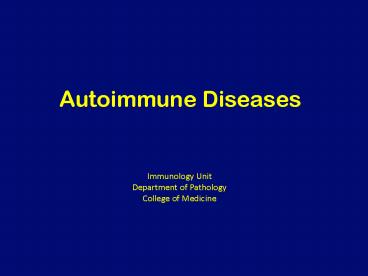Autoimmune Diseases - PowerPoint PPT Presentation
1 / 28
Title:
Autoimmune Diseases
Description:
... IL-1 Pathogenesis (Type ... Calibri Arial Rounded MT Bold Times New Roman Office Theme Slide 1 Objectives Slide 3 Slide 4 Slide 5 Slide 6 Slide 7 Slide 8 Slide 9 ... – PowerPoint PPT presentation
Number of Views:94
Avg rating:3.0/5.0
Title: Autoimmune Diseases
1
Autoimmune Diseases
Immunology Unit Department of Pathology College
of Medicine
2
Objectives
- To know that the inflammatory processes in auto
immune diseases are mediated by hypersensitivity
reactions (type II, III and IV) - To know that autoimmune diseases can be either
organ specific or may be generalized involving
many organs or tissues - To understand that the manifestations of
autoimmune diseases depend upon the organ and the
degree of damage inflicted on the target tissues
3
Disease processes and tissue damage are due to
Type II Type III and Type IV hypersensitivity
reactions
4
(No Transcript)
5
(No Transcript)
6
(No Transcript)
7
Organ Specific Autoimmune Diseases
Mediated by 1) Direct cellular
damage - Hashimotos thyroiditis or 2)
Antibodies Stimulating or blocking
auto-antibodies - Graves disease (Stimulating
antibodies) - Myasthenia gravis (Blocking
Antibodies)
8
1. Graves Disease (Thyrotoxicosis)
- Production of thyroid hormones is regulated by
thyroid-stimulating hormones (TSH) - The binding of TSH to a receptor on thyroid cells
stimulates the synthesis of two thyroid hormones
thyroxine and triiodothyronine
9
- A person with Graves Disease makes
auto-antibodies to the receptor for TSH. - Binding of these auto-antibodies to the receptor
mimics the normal action of TSH leading to
over-stimulation of the thyroid gland
10
2. Myasthenia Gravis
- Clinically characterised by weakness and
fatigability on sustained effort - Antibodies directed against acetylcholine
receptor (AChR) - IgG Ab interact with the postsynaptic AChR at the
nicotinic neuromuscular junction (NMJ) - There is reduction in the number of functional
AChR receptors by increasing complement mediated
degradation of receptors
11
Myasthenia gravis
Motor end-plates of muscles
12
- Systemic Autoimmune Immune diseases
- Systemic lupus erythematosis (SLE)
Systemic lupus erythematosis is the most common
autoimmune disorder The characteristic
butterfly rash is made worse by exposure to
sunlight Lupus is a potentially fatal autoimmune
disease
13
(No Transcript)
14
(No Transcript)
15
Auto antibodies
- The anti-nuclear antibody (ANA) test is the best
screening test for SLE and is determined by
immunofluorescence or ELISA tests - The ANA is positive in significant titer (usually
1160 or higher) in virtually all patients with
SLE
16
(No Transcript)
17
Other investigations
- Anti-double-stranded DNA titers
- Complement Levels (CH50, C3, C4)
- ESR
- CRP
- Complement Split products
- Decreased complement C1q
18
Treatment
NSAIDs (Non-steroidal anti-inflammatory
drugs) Antimalarials (Hydroxychloroquine) Immuno
suppressive agents
19
2. Rheumatoid Arthritis
- Rheumatoid arthritis is an autoimmune disease in
which the normal immune response is directed
against an individual's own tissue, including the
- Joints
- Tendons
- Bones
- Resulting in inflammation and destruction of
these tissues
20
Rheumatoid Arthritis (Contd.)
- The cause of rheumatoid arthritis is not known
- Investigating possibilities of a foreign antigen,
such as a virus
- Both prevalence and incidence are 2-3 times
greater in women than in men
21
Pathogenesis (Type III hypersensitivity reaction)
In rheumatoid arthritis, many individuals produce
a group of auto-antibodies known as rheumatoid
factor These antibodies react with determinants
in the FC region of IgG
22
Rheumatoid Factor
The classic rheumatoid factor is an IgM
antibody with this kind of reactivity
23
Pathogenesis (Type III hypersensitivity reaction)
Such auto-antibodies bind to normal circulating
IgG, forming IgM-IgG complexes which may be
deposited in joints. This leads to activation
of synovial macrophages The macrophages engulf
the immune complexes and then release TNF and
other pro-inflammatory cytokines e.g., IL-1
24
Pathogenesis (Type III hypersensitivity
reaction)
- TNF induces the secretion of metalloproteinases
which are known to cause joint destruction - T cell activation due to unknown antigens also
contributes to the inflammation in RA
25
Rheumatoid Arthritis
Rheumatoid arthritis (RA) affects peripheral
joints and may cause destruction of both
cartilage and bone.
26
Treatment and Prognosis
- Medications
- NSAIDS (Non-steroidal anti-inflammatory drugs)
- Disease-modifying drugs (eg, gold,
hydroxychloroquine, sulfasalazine, penicillamine)
- Immunosuppressive therapy
- Corticosteroids
- Methotrexate
- Surgery
- Physical therapy
27
Take home message
- The spectrum of autoimmune disorders is wide
ranging from single organ involvement to a
systemic disease - The disease process is usually prolonged and is
generally associated with significant morbidity
and mortality - The mainstay of the treatment is to maintain
immunosuppression
28
Thank you































